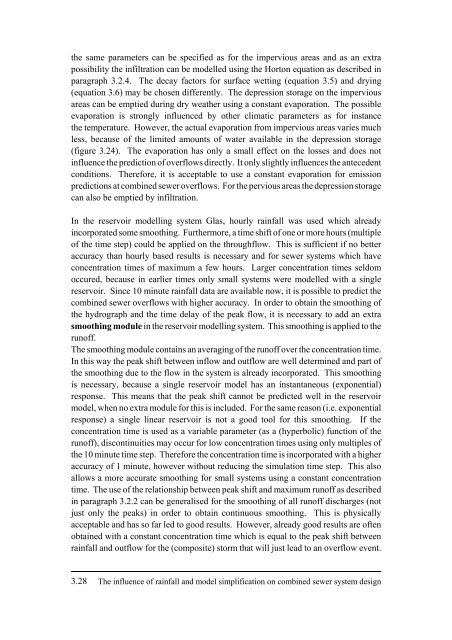Chapter 3 : Reservoir models - KU Leuven
Chapter 3 : Reservoir models - KU Leuven
Chapter 3 : Reservoir models - KU Leuven
Create successful ePaper yourself
Turn your PDF publications into a flip-book with our unique Google optimized e-Paper software.
the same parameters can be specified as for the impervious areas and as an extra<br />
possibility the infiltration can be modelled using the Horton equation as described in<br />
paragraph 3.2.4. The decay factors for surface wetting (equation 3.5) and drying<br />
(equation 3.6) may be chosen differently. The depression storage on the impervious<br />
areas can be emptied during dry weather using a constant evaporation. The possible<br />
evaporation is strongly influenced by other climatic parameters as for instance<br />
the temperature. However, the actual evaporation from impervious areas varies much<br />
less, because of the limited amounts of water available in the depression storage<br />
(figure 3.24). The evaporation has only a small effect on the losses and does not<br />
influence the prediction of overflows directly. It only slightly influences the antecedent<br />
conditions. Therefore, it is acceptable to use a constant evaporation for emission<br />
predictions at combined sewer overflows. For the pervious areas the depression storage<br />
can also be emptied by infiltration.<br />
In the reservoir modelling system Glas, hourly rainfall was used which already<br />
incorporated some smoothing. Furthermore, a time shift of one or more hours (multiple<br />
of the time step) could be applied on the throughflow. This is sufficient if no better<br />
accuracy than hourly based results is necessary and for sewer systems which have<br />
concentration times of maximum a few hours. Larger concentration times seldom<br />
occured, because in earlier times only small systems were modelled with a single<br />
reservoir. Since 10 minute rainfall data are available now, it is possible to predict the<br />
combined sewer overflows with higher accuracy. In order to obtain the smoothing of<br />
the hydrograph and the time delay of the peak flow, it is necessary to add an extra<br />
smoothing module in the reservoir modelling system. This smoothing is applied to the<br />
runoff.<br />
The smoothing module contains an averaging of the runoff over the concentration time.<br />
In this way the peak shift between inflow and outflow are well determined and part of<br />
the smoothing due to the flow in the system is already incorporated. This smoothing<br />
is necessary, because a single reservoir model has an instantaneous (exponential)<br />
response. This means that the peak shift cannot be predicted well in the reservoir<br />
model, when no extra module for this is included. For the same reason (i.e. exponential<br />
response) a single linear reservoir is not a good tool for this smoothing. If the<br />
concentration time is used as a variable parameter (as a (hyperbolic) function of the<br />
runoff), discontinuities may occur for low concentration times using only multiples of<br />
the 10 minute time step. Therefore the concentration time is incorporated with a higher<br />
accuracy of 1 minute, however without reducing the simulation time step. This also<br />
allows a more accurate smoothing for small systems using a constant concentration<br />
time. The use of the relationship between peak shift and maximum runoff as described<br />
in paragraph 3.2.2 can be generalised for the smoothing of all runoff discharges (not<br />
just only the peaks) in order to obtain continuous smoothing. This is physically<br />
acceptable and has so far led to good results. However, already good results are often<br />
obtained with a constant concentration time which is equal to the peak shift between<br />
rainfall and outflow for the (composite) storm that will just lead to an overflow event.<br />
3.28<br />
The influence of rainfall and model simplification on combined sewer system design
















